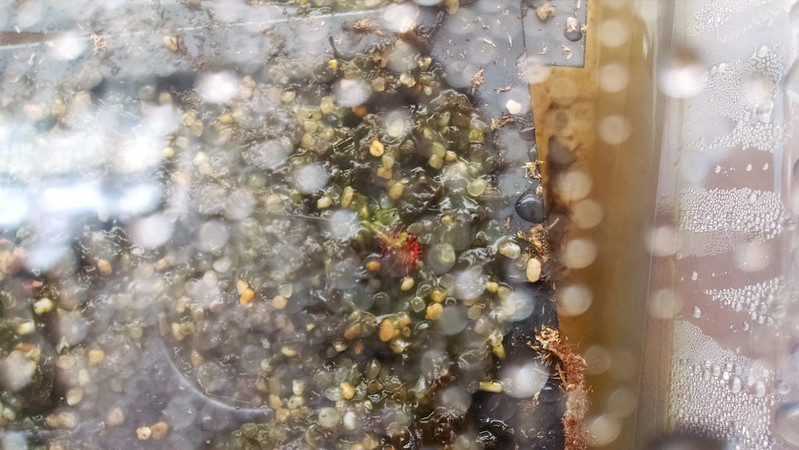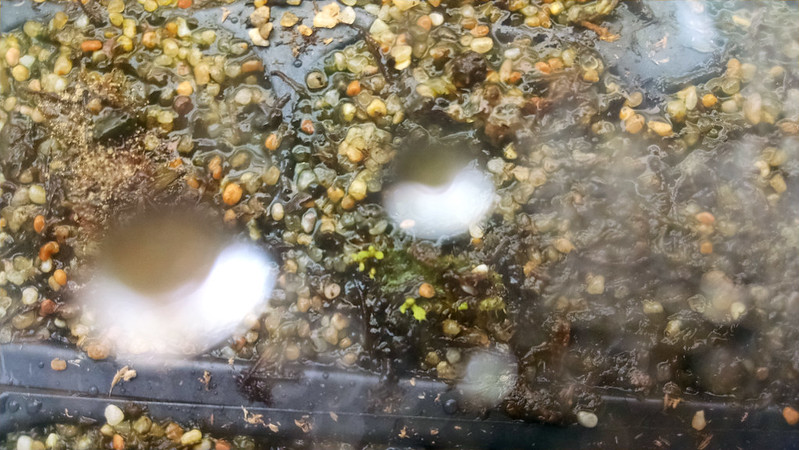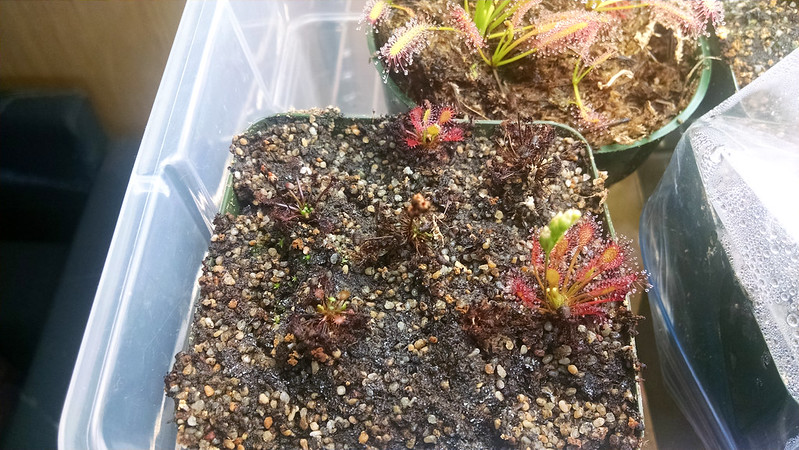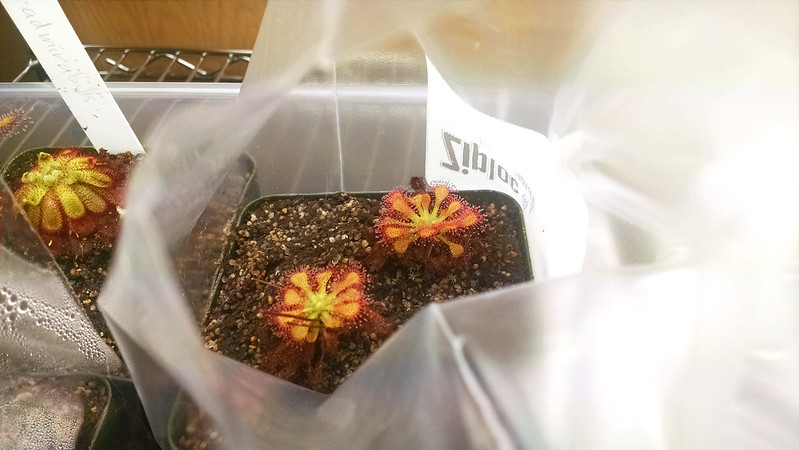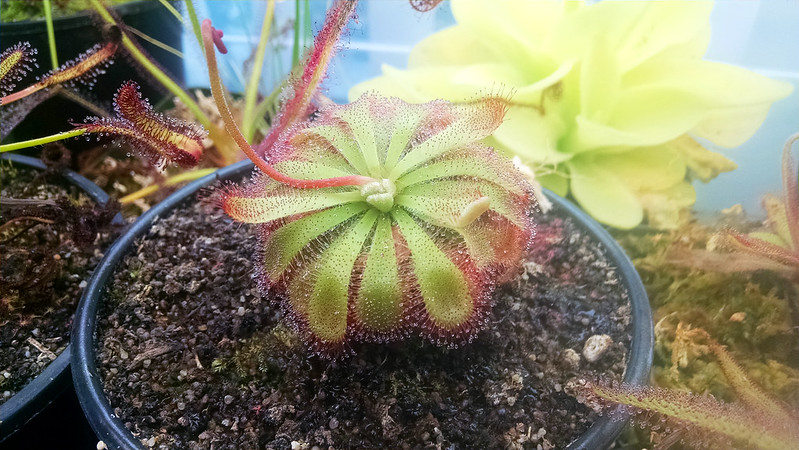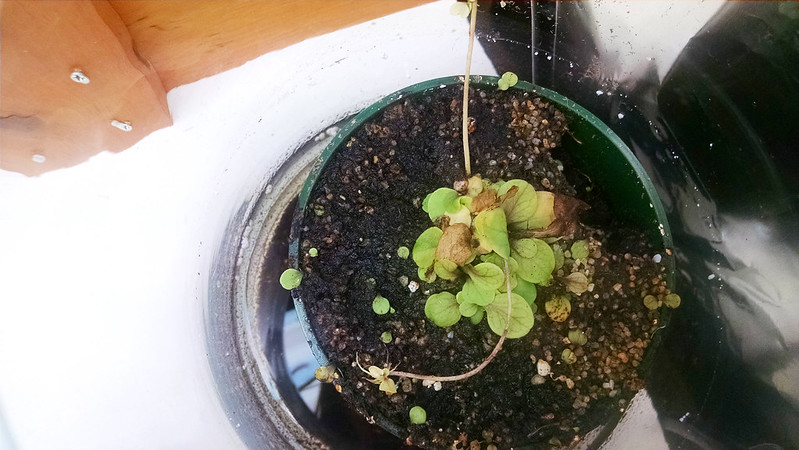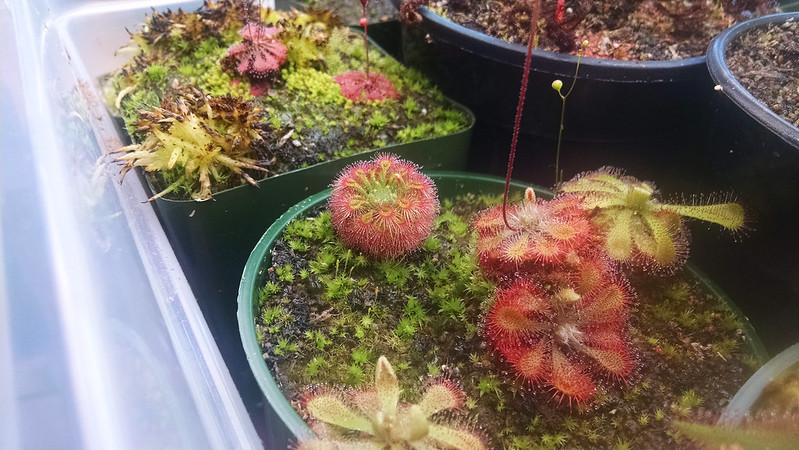For some time now I've been dissatisfied with how my plants are arranged in their growspaces. Some spots were crowded, others had lots of wasted empty space. Yesterday I had a couple hours free to fiddle with things, and while it's not 100% optimized, I feel like things are in a much better way generally.
First up was my first growing area. This spot saw the most reorganization, because it houses my Drosera 'Marston Dragon', which is huge, and my collection of Utricularia, which are weeds (and therefore housed mostly in solo containers).
Here's a shot of the first area before reorganization.
As you can see, the lights are very high, to accommodate both the D. 'Marston Dragon' on the far right, and the two Drosera binata clones in the tray, which were both growing up into the lights. As a result, the shorter plants were getting much less intense light. Also notice how much empty space there is around the D. 'Marston Dragon' and the utrics. Waste!
And here it is after reorganization.
While the lights are still high, I was able to raise the milk crates with some lumber, since the two D. binata clones are living down on the right with my D. 'Marston Dragon' and the utrics. I also moved down my Drosera spiralis, which is getting really tall. Incidentally, I also took the opportunity to remove a grassy weed that had taken root in the pot. As in, its roots were 2 feet long and had gone all around the tray. Hopefully I don't find it popping up elsewhere.
While this still isn't as efficient a use of space as I'd like, I do have a lot more room in the large tray to expand. The main difficulty has been fitting the Dragon in with other plants. Also, I need to find some small square containers for utrics that will fit together more nicely than the round ones I have.
The second growing area didn't go through as much of a shift, because it was being more efficiently used to begin with. Here it is before.
And then after reorganization.
The primary change is that the tall-sided tray on the right has been swapped out for two shallower (and thus easier to access) trays side-by-side. I've also moved some shorter plants from the first area over here, and took some of the taller ones from here over there. Generally, plant density has increased, which is made easier by the fact that almost all the pots in here are square.
My favorite change though was a total accident. In order to get better access to the plants, I raised the lights in front up 4 inches or so, while leaving the back down low. It made a world of difference! I can see my plants better, reach in to access them for feeding, it's great. Ever since I'd filled this growspace I've been frustrated with how difficult it is to enjoy the plants I have growing in here, and this has made it so much better. What a simple fix.
Now, it has also lowered the light level for the plants in front. We'll have to see how that goes, but I suspect it will be fine. This is always a tradeoff when growing plants under lights, and it has to reflect why you are growing them. I know some people use LEDs to grow, in order to give plants more of the red and blue spectrum they need. LEDs are more efficient than fluoros, and the plants probably appreciate it. However, I grow my plants because they are beautiful, and I want to have them on display to be admired whenever, not bathed in weird colors. Therefore, I sometimes sacrifice optimal lighting for better aesthetics. If I were growing commercially I would absolutely use LEDs for propagation and growing out, weird light colors be damned.
In any case, that's what I think about lighting. Here's my propagation area, the only change to which has been that now its even emptier. Before:
And then after:
I clearly need to get more plants into propagation.
I'm glad I got my growing areas in order. I'm much happier with how they look, and am looking forward to getting more plants to fill them up even more.
Finally, an update on the Summer Batch. While I was moving things around I peeked in to see if there was any more action. Several of the leaf cutting strikes had gotten markedly bigger, and the Drosera tokaiensis and Drosera capillaris seedlings are much more noticeable. In addition, I noticed a strike on...Drosera venusta!
I also noticed new strikes on Drosera madagascariensis. Looks like I've got some new plants on the way :)
First up was my first growing area. This spot saw the most reorganization, because it houses my Drosera 'Marston Dragon', which is huge, and my collection of Utricularia, which are weeds (and therefore housed mostly in solo containers).
Here's a shot of the first area before reorganization.
 |
| This arrangement was very ad hoc, and I'd never cared for it. |
And here it is after reorganization.
 |
| It's still got problems, but this is a lot better than it was. |
While this still isn't as efficient a use of space as I'd like, I do have a lot more room in the large tray to expand. The main difficulty has been fitting the Dragon in with other plants. Also, I need to find some small square containers for utrics that will fit together more nicely than the round ones I have.
The second growing area didn't go through as much of a shift, because it was being more efficiently used to begin with. Here it is before.
 |
| This area had always felt cramped when it was like this. |
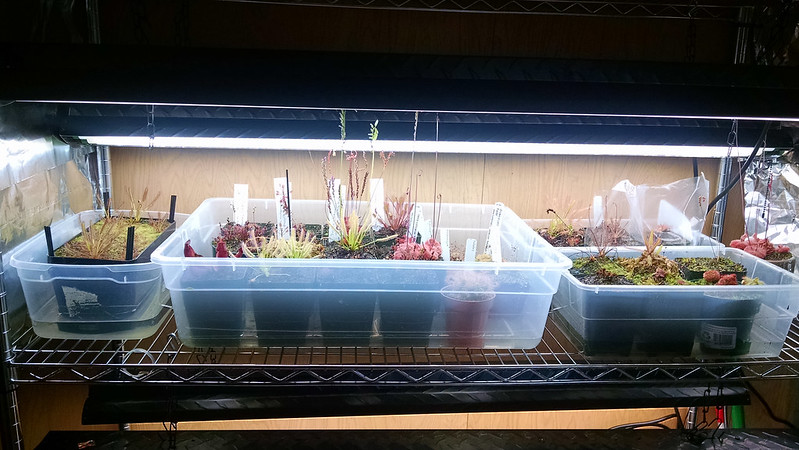 |
| Everything feels airier and less cramped now. |
My favorite change though was a total accident. In order to get better access to the plants, I raised the lights in front up 4 inches or so, while leaving the back down low. It made a world of difference! I can see my plants better, reach in to access them for feeding, it's great. Ever since I'd filled this growspace I've been frustrated with how difficult it is to enjoy the plants I have growing in here, and this has made it so much better. What a simple fix.
Now, it has also lowered the light level for the plants in front. We'll have to see how that goes, but I suspect it will be fine. This is always a tradeoff when growing plants under lights, and it has to reflect why you are growing them. I know some people use LEDs to grow, in order to give plants more of the red and blue spectrum they need. LEDs are more efficient than fluoros, and the plants probably appreciate it. However, I grow my plants because they are beautiful, and I want to have them on display to be admired whenever, not bathed in weird colors. Therefore, I sometimes sacrifice optimal lighting for better aesthetics. If I were growing commercially I would absolutely use LEDs for propagation and growing out, weird light colors be damned.
In any case, that's what I think about lighting. Here's my propagation area, the only change to which has been that now its even emptier. Before:
 |
| This area really needed the least work. |
 |
| It feels so empty. |
I'm glad I got my growing areas in order. I'm much happier with how they look, and am looking forward to getting more plants to fill them up even more.
Finally, an update on the Summer Batch. While I was moving things around I peeked in to see if there was any more action. Several of the leaf cutting strikes had gotten markedly bigger, and the Drosera tokaiensis and Drosera capillaris seedlings are much more noticeable. In addition, I noticed a strike on...Drosera venusta!
 |
| D. venusta leaf cutting reaching for the stars. |
The Summer Batch
Sown/Started:
Germinated/Struck:
Sown/Started:
- 7-9-14 Drosera intermedia 'Cuba'
- 7-9-14 Drosera burmannii Humpty Doo
- 7-9-14 Drosera tokaiensis
- 7-9-14 Drosera capillaris Alabama
- 7-9-14 Drosera adelae
- 7-9-14 Drosera anglica CA x HI
- 7-9-14 Drosera madagascariensis Masoala, Madagascar
- 7-9-14 Drosera venusta
Germinated/Struck:
- 8-4-14 Drosera anglica CA x HI, struck. Date approximate.
- 8-11-14 Drosera tokaiensis, germinated.
- 8-11-14 Drosera capillaris Alabama, germinated.
- 8-11-14 Drosera madagascariensis Masoala, Madagascar, struck
- 8-11-14 Drosera adelae, struck
- 8-14-14 Drosera venusta, struck



